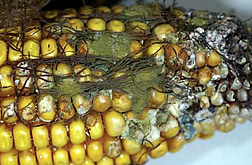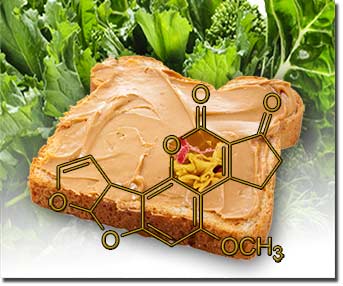Mycotoxin
What is it?
A mycotoxin is a toxic secondary metabolite produced by fungi, one species being Aspergillus flavus. Not all species of Aspergillus produce mycotoxins but A. flavus is among those who do.
These mycotoxins produced are called aflatoxins; they are not constantly produced but can be triggered to do so by factors including stress of the organism. The “afla” in aflatoxin looks a lot like A. flavus, right? Well that’s because that is how it got its name! Aflatoxins are highly toxic and carcinogenic to animals. Crops and other foods, such as corn and peanuts, are often contaminated with aflatoxins. There are regulatory limits for the amount of aflatoxins considered to be safe in foods; however no limit for concentrations in buildings despite the danger. Aflatoxin B1 is the most common and most carcinogenic aflatoxin. Another would be aflatoxin G1.
Aflatoxins cause liver cells to break down and also blockage of the hepatic vein, while at the same time inducing the proliferation of bile duct cells. Aflatoxin does this by gluing DNA together so it can’t replicate and can’t form messenger RNA. These effects can result in a non-functional liver and eventually death of an organism. All mammals are susceptible to aflatoxin but its effects vary between species and type of aflatoxin involved.
The amount of toxin that is formed depends partly upon the particular strain of A. flavus present, but can also vary greatly when a single strain is grown on different media. This indicates that toxin-production is controlled partly genetically and partly physiologically.
Aflatoxicosis
If an organism is poisoned by aflatoxin mycotoxins, it is referred to as aflatoxicosis. This typically occurs from ingesting food that is contaminated with aflatoxin mycotoxins. Aflatoxicosis damages the liver more than any other organ and also suppresses the immune system. Unfortunately, drugs and antibiotics aren’t very helpful for aflatoxicosis.
Controlling the Issue
 According to the American Food and Agriculture Organization it is
estimated that 25% of the food crops in the world are affected by
mycotoxins. Of these mycotoxins, aflatoxins are the biggest problem.
The crops most at risk of being contaminated by aflatoxins are corn,
cottonseed and peanuts. However beans, rice, tree nuts and wheat may
also be contaminated. It grows less often on other grains and nuts.
Aflatoxins are found all over the world but are much more of a
problem in undeveloped or developing nations than they are in
developed countries. Most developed countries prohibit high levels
of aflatoxin mycotoxins in foods. For example, the United States
limits the level of aflatoxins to under 20 parts per billion in
food. Aflatoxins are removed by chemical processes, however small
amounts are still present in corn and peanuts. This amount is
usually far below the safety limit. Even so, long-term intake
of small amounts should be done with caution. (Sorry peanut
butter and corn lovers).
According to the American Food and Agriculture Organization it is
estimated that 25% of the food crops in the world are affected by
mycotoxins. Of these mycotoxins, aflatoxins are the biggest problem.
The crops most at risk of being contaminated by aflatoxins are corn,
cottonseed and peanuts. However beans, rice, tree nuts and wheat may
also be contaminated. It grows less often on other grains and nuts.
Aflatoxins are found all over the world but are much more of a
problem in undeveloped or developing nations than they are in
developed countries. Most developed countries prohibit high levels
of aflatoxin mycotoxins in foods. For example, the United States
limits the level of aflatoxins to under 20 parts per billion in
food. Aflatoxins are removed by chemical processes, however small
amounts are still present in corn and peanuts. This amount is
usually far below the safety limit. Even so, long-term intake
of small amounts should be done with caution. (Sorry peanut
butter and corn lovers).
For a list of other mycotoxins and their producers visit this page:
http://www.mold-help.org/content/view/457/
Another way that A. flavus can harm animals is by aspergillosis, continue on to learn more about this disease.




